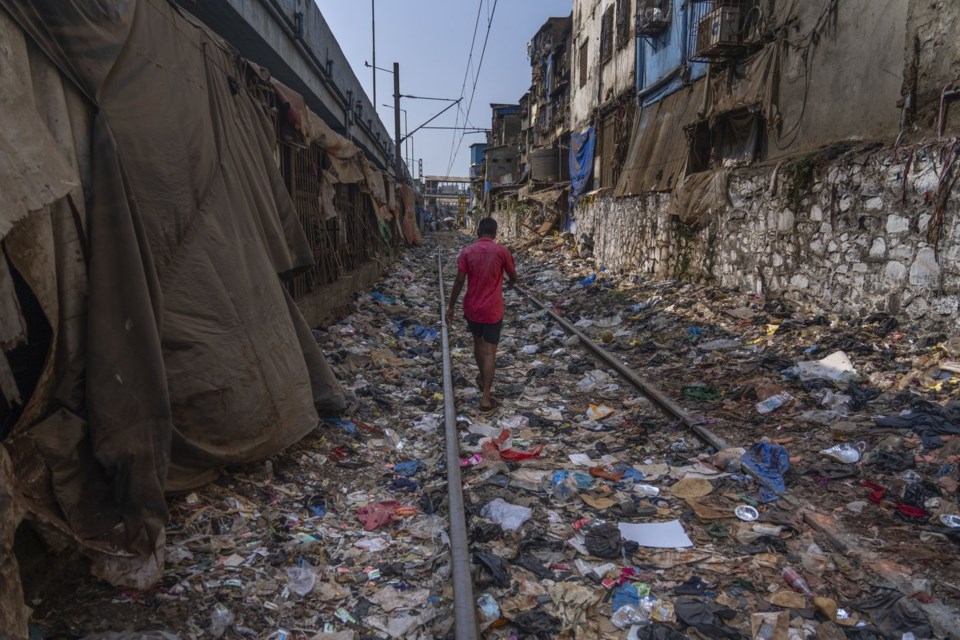The world creates 57 million tons of plastic pollution every year and spreads it from the deepest oceans to the highest mountaintop to the inside of people's bodies, according to a new study that also said more than two-thirds of it comes from the Global South.
It's enough pollution each year — about 52 million metric tons — to fill New York City’s Central Park with plastic waste as high as the Empire State Building, according to researchers at the University of Leeds in the United Kingdom. They examined waste produced on the local level at more than 50,000 cities and towns across the world for a study in Wednesday’s journal Nature.
The study examined plastic that goes into the open environment, not plastic that goes into landfills or is properly burned. For 15% of the world's population, government fails to collect and dispose of waste, the study's authors said — a big reason Southeast Asia and Sub-Saharan Africa produce the most plastic waste. That includes 255 million people in India, the study said.
Lagos, Nigeria, emitted the most plastic pollution of any city, according to study author Costas Velis, a Leeds environmental engineering professor. The other biggest plastic polluting cities are New Delhi; Luanda, Angola; Karachi, Pakistan and Al Qahirah, Egypt.
India leads the world in generating plastic pollution, producing 10.2 million tons a year (9.3 million metric tons), far more than double the next big-polluting nations, Nigeria and Indonesia. China, often villainized for pollution, ranks fourth but is making tremendous strides in reducing waste, Velis said. Other top plastic polluters are Pakistan, Bangladesh, Russia and Brazil. Those eight nations are responsible for more than half of the globe's plastic pollution, according to the study's data.
The United States ranks 90th in plastic pollution with more than 52,500 tons (47,600 metric tons) and the United Kingdom ranks 135th with nearly 5,100 tons (4,600 metric tons), according to the study.
In 2022, most of the world’s nations agreed to make the first legally binding treaty on plastics pollution, including in the oceans. Final take place in South Korea in November.
The study used artificial intelligence to concentrate on plastics that were improperly burned — about 57% of the pollution — or just dumped. In both cases incredibly tiny microplastics, or nanoplastics, are what turn the problem from a to a human health threat, Velis said.
Several studies this year have looked at how prevalent microplastics are and in people's tissue, such as , and , with doctors and scientists in terms of human health threats.
“The big time bomb of microplastics are these microplastics released in the Global South mainly,” Velis said. “We already have a huge dispersal problem. They are in the most remote places ... the , in the in the ocean, in what we breathe and what we eat and what we drink.”
He called it “everybody's problem” and one that will haunt future generations.
“We shouldn't put the blame, any blame, on the Global South,” Velis said. “And we shouldn't praise ourselves about what we do in the Global North in any way.”
It's just a lack of resources and ability of government to provide the necessary services to citizens, Velis said.
Outside experts worried that the study's focus on pollution, rather than overall production, lets the plastics industry off the hook. Making plastics emits that contribute to .
“These guys have defined plastic pollution in a much narrower way, as really just macroplastics that are emitted into the environment after the consumer, and it risks us losing our focus on the upstream and saying, hey now all we need to do is manage the waste better," said Neil Tangri, senior director of science and policy at GAIA, a global network of advocacy organizations working on zero waste and environmental justice initiatives. “It’s necessary but it’s not the whole story.”
Theresa Karlsson, science and technical advisor to International Pollutants Elimination Network, another coalition of advocacy groups on environment, health and waste issues, called the volume of pollution identified by the study “alarming” and said it shows the amount of plastics being produced today is “unmanageable.”
But she said the study misses the significance of the global trade in plastic waste that has rich countries sending it to poor ones. The study said plastic waste trade is decreasing, with China banning waste imports. But Karlsson said overall waste trade is actually increasing and likely plastics with it. She cited EU waste exports going from 110,000 tons (100,000 metric tons) in 2004 to 1.4 million tons (1.3 million metric tons) in 2021.
Velis said the amount of plastic waste traded is small. Kara Lavender Law, an oceanography professor at the Sea Education Association who wasn't involved in the study, agreed, based on U.S. plastic waste trends. She said this was otherwise one of the more comprehensive studies on plastic waste.
Officials in the plastics industry praised the study.
“This study underscores that uncollected and unmanaged plastic waste is the largest contributor to plastic pollution and that prioritizing adequate waste management is critical to ending plastic pollution,” Chris Jahn, council secretary of the International Council on Chemical Associations, said in a statement. In treaty negotiations, the industry opposes a cap on plastic production.
The United Nations is likely to rise from about 440 million tons (400 million metric tons) a year to more than 1,200 million tons (1,100 million metric tons, saying “our planet is choking in plastic.”
___
Jennifer McDermott contributed from Providence, Rhode Island.
___
Follow Seth Borenstein on X at
___
Read more of AP’s climate coverage at
___
The Associated Press’ climate and environmental coverage receives financial support from multiple private foundations. AP is solely responsible for all content. Find AP’s for working with philanthropies, a list of supporters and funded coverage areas at .
Seth Borenstein, The Associated Press




